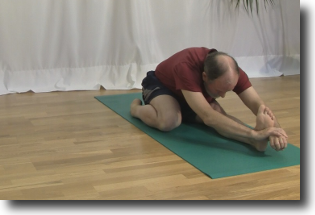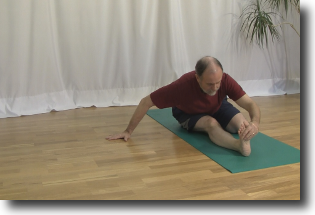The fence was new once, but now it is getting to be quite old. The paint is faded and peeling in many places, but the sure sign of the age of the fence is how much it is leaning to the side. There are parts of it that have fallen completely down to the ground and other parts that are threatening to fall at any moment and surprisingly there are parts of it that are completely upright.
This old fence looks like some people when they attempt to do Triang Mukha Eka Pada Paschimottanasana. There body is falling over to the side like the fence.
You can prop up the old fence to prevent it from falling down and you can prop up your torso in this pose to prevent it from falling down as well.
First we will have a look at Triang Mukha Eka Pada Paschimottanasana and how to do the pose and then we will learn how to eliminate the falling fence problem.
What is Triang Mukha Eka Pada Paschimottanasana
This is one of the seated postures that appears early in the Ashtanga Yoga Primary series. This particular pose is working on stretching the quadriceps, ankle and hamstring muscles.
The Sanskrit name translates as “three limbs facing one foot forward fold” which is a descriptive name of the pose.
If you have enough flexibility in your quadriceps and hips this pose is fairly easy to do.
How to do the pose
First you start in Dandasana, seated on the floor with both legs together out in front of you and your hands on the floor beside your hips.
From Dandasana you inhale and fold your right leg back at the knee and bring your shin and the top of your right foot to the floor beside your hip. The heel of your right foot is pointing towards the ceiling and it is beside your hip.
There should be a small space between your heel and your hip. Think of making a pocket that your hand could slip into.
Now that your right leg is in place, check to make sure that both of your sitz bones are on the floor.
Exhale, engage Uddiyana Bandha and tip the top of your hips forward as you bring your torso forward and down towards your extended right leg. Bring both of your arms forward and take a hold of the foot of your extended leg.
You continue to lower your torso towards your thigh and bring your gaze towards your extended foot.
Hold here for several breaths and then repeat the pose with the other leg folded back.
What is the falling fence problem
The most common problem with this pose is that you can not get one or both of your sitz bones to touch the floor. You will discover that your hips are stuck up in the air and that your torso is leaning over to the side and you look like that old fence that is about to fall down.
The usual reason for your hips being in the air instead of firmly on the floor is tension in the quadriceps. They will need to stretch and lengthen to allow your hips to lower to the floor.
The usual reason for your hips being in the air instead of firmly on the floor is tension in the quadriceps. They will need to stretch and lengthen to allow your hips to lower to the floor.
While your quadriceps are slowly stretching over time you need to support yourself in this pose to prevent injury.
How to work with the falling fence problem
There are two ways to deal with this problem of your sitz bones being up in the air depending on the severity.
If the quadriceps are really tight and both sitz bones are off of the floor then you want to use a foam. However if you have one sitz bone on your mat and you are only tipped over to the side a little bit then you can use your arm out to the side as a prop.
Let’s look at these two options in detail starting with the most severe case first.
1 – use a foam to support your hips
You use a foam when both hip’s sitz bones are off of the floor and your torso is tipped to the side a lot. There may be a lot of discomfort in the folded leg in which case this is the right option to use.
You look like that old fence that is about to collapse completely on to the ground.
Place one or more foam blocks under both sitz bones. Usually one 2 inch thick foam block is enough support but sometimes you may need two.
You know you have enough foams under your hips when
- your torso is now straight up and down,
- there is no more pain coming from the folded leg and
- the weight on your sitz bones is evenly distributed.
Once you have the foams in place you fold forward and continue with the remainder of the posture.
If you only have a mild case of tipping over when your fold your right leg back then this second option is your best choice.
2 – use your hand out to the side
If you have one sitz bone on the floor and the other is up in the air slightly then this is the option for you. If you are only tipped to the side a little bit and there is no discomfort in your folded leg then you can use this option to complete the pose.
In this case the old fence is only leaning to the side and it is in no danger of falling down. It only needs a little work to get back to a vertical position.
After you have folded your right leg back you discover that your right sitz bone is up in the air and your left sitz bone is on the ground.
Now bring your left arm out to the side and use it as a support to keep your torso from tipping over.
As you fold forward it is important to get your left hand to the floor in the proper place to provide the maximum amount of support.
Once your torso is as far forward as it will go your hand should be on the floor in line with your shoulders and your elbow should be slightly bent. This arrangement with the arm bent slightly and in line with both of your shoulders will supply the maximum support for your torso and your hips.
Summary
In Triang Mukha Eka Pada Paschimottanasana you may look like
- an old fence that has fallen down
- a fence that needs a little support to keep it upright or
- a brand new fence that is perfectly straight up and down.
Depending on which of the first two fences you are you will need some support to help you to do this pose safely.
Next Step
Some times you will not realize that you are tipping over to the side. Ask your teacher to check out your alignment in the pose. They will be able to tell you if you look like an old fence or a brand new fence. They will be able to help you become a brand new fence and prevent you from getting injured.






